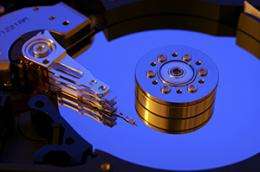Using the correct annealing temperature is key to making fast, non-volatile computer memory

Computers often do not run as fast as they should because they are constantly transferring information between two kinds of memory: a fast, volatile memory connected to the CPU, and a slow, non-volatile memory that remembers data even when switched off. A universal memory that is fast, power-efficient and non-volatile would allow new designs that avoid this bottleneck. Hao Meng and co-workers at the A*STAR Data Storage Institute have now shed new light on how to manufacture such a memory.
The researchers explored a special class of universal memory called spin-transfer torque magnetic random access memory (MRAM). A spin-transfer torque MRAM typically comprises two magnetic films that are separated by an insulating layer. The resistance between the two films is low if the magnetization direction in each film is parallel, and high if it is anti-parallel. Information is stored in the relative magnetization between the two films, and read out by measuring resistance. The magnetization directions can be switched by applying spin torque to the films’ magnetic domains (using a spin polarized electric current).
High-temperature annealing is a key step in the manufacture of an MRAM cell. Annealing alters the crystal structure of the cell materials, which in turn changes the degree of magnetization and how the cell functions. In particular, the greater change in resistance between parallel and anti-parallel magnetizations, the better the memory will function. Previous studies have shown that this resistance change increases as the annealing temperature increases, but drops if the annealing temperature rises too much.
Meng and co-workers extended this analysis to other critical MRAM characteristics. They focused on a cell made with CoFeB magnetic films, which has a natural magnetization direction outside of the plane of the film. They found that the annealing temperature that yielded maximum resistance variation exceeded the temperature necessary for maximum thermal stability. This is critical information for design engineers, who must balance these two metrics against each other.
Meng and co-workers also found that the minimum current density necessary to change the film magnetization increased with annealing temperature. A lower current is desirable for practical cell operation. The current density could be lowered by reducing the thickness of the magnetic films. However, lower thicknesses also produced an undesirable reduction in resistance variation. By explicitly demonstrating the trade-offs necessary in the design of spin torque MRAMs, the data is expected to help engineers design the next generation of these promising devices.
More information: Meng, H., Sbiaa, R., Wang, C. C., Lua, S. Y. H. & Akhtar, M. A. K. Annealing temperature window for tunneling magnetoresistance and spin torque switching in CoFeB/MgO/CoFeB perpendicular magnetic tunnel junctions. Journal of Applied Physics 110, 103915 (2011).dx.doi.org/10.1063/1.3662893
Journal information: Journal of Applied Physics

















